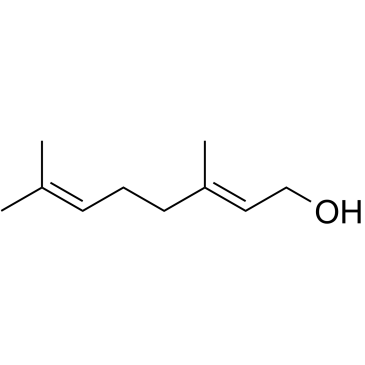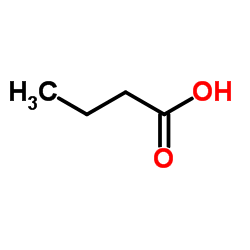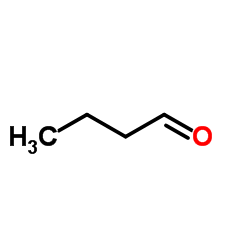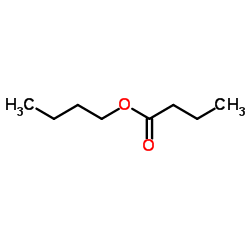106-29-6
| 中文名 | 丁酸香叶酯 |
|---|---|
| 英文名 | Geranyl butyrate |
| 中文别名 | 丁酸叶醇酯 |
| 英文别名 |
MFCD00036538
EINECS 203-381-3 Butanoic acid, 3,7-dimethyl-2,6-octadien-1-yl ester GERANYL BUTYRATE 3,7-Dimethylocta-2,6-dien-1-yl butyrate 3,7-Dimethyl-2,6-octadien-1-yl butyrate |
| 密度 | 0.9±0.1 g/cm3 |
|---|---|
| 沸点 | 299.9±19.0 °C at 760 mmHg |
| 分子式 | C14H24O2 |
| 分子量 | 224.339 |
| 闪点 | 99.4±19.9 °C |
| 精确质量 | 224.177628 |
| PSA | 26.30000 |
| LogP | 5.17 |
| 外观性状 | 无色至淡黄色液体 |
| 蒸汽压 | 0.0±0.6 mmHg at 25°C |
| 折射率 | 1.460 |
| 储存条件 | 玻璃瓶包装。贮存于阴凉通风处。 |
| 稳定性 | 具有苹果和玫瑰花香味。天然品主要存在于薰衣草油中。 无色液体。新鲜果香,似玫瑰香气和杏的甜味。 易溶于乙醇、乙醚、丙酮、乙酸乙酯等有机溶剂,不溶于水、甘油、丙二醇。 |
| 分子结构 | 1、 摩尔折射率:68.48 2、 摩尔体积(cm3/mol):249.9 3、 等张比容(90.2K):580.6 4、 表面张力(dyne/cm):29.1 5、 介电常数: 6、 偶极距(10-24cm3): 7、 极化率:27.14 |
| 计算化学 | 1、 疏水参数计算参考值(XlogP):4.3 2、 氢键供体数量:0 3、 氢键受体数量:2 4、 可旋转化学键数量:8 5、 互变异构体数量: 6、 拓扑分子极性表面积(TPSA):26.3 7、 重原子数量:16 8、 表面电荷:0 9、 复杂度:258 10、同位素原子数量:0 11、确定原子立构中心数量:0 12、不确定原子立构中心数量:0 13、确定化学键立构中心数量:1 14、不确定化学键立构中心数量:0 15、共价键单元数量:1 |
| 更多 | 1. 性状:无色至淡黄色油状液体 2. 密度(g/mL,25℃):0.896 3. 相对蒸汽密度(g/mL,空气=1):未确定 4. 熔点(ºC):未确定 5. 沸点(ºC,常压):未确定 6. 沸点(ºC, 18mmHg):253 7. 折射率(D20):1.461 8. 闪点(ºC):93 9. 比旋光度(ºC):未确定 10. 自燃点或引燃温度(ºC): 未确定 11. 蒸气压(mmHg,20ºC):未确定 12. 饱和蒸气压(kPa, ºC):未确定 13. 燃烧热(KJ/mol):未确定 14. 临界温度(ºC):未确定 15. 临界压力(KPa):未确定 16. 油水(辛醇/水)分配系数的对数值:未确定 17. 爆炸上限(%,V/V):未确定 18. 爆炸下限(%,V/V):未确定 19. 溶解性:易溶于乙醇、乙醚、丙酮、乙酸乙酯等有机溶剂,不溶于水、甘油、丙二醇。 |
|
SECTION 1: Identification of the substance/mixture and of the company/undertaking Product identifiers Product name: Geranyl butyrate REACH No.: A registration number is not available for this substance as the substance or its uses are exempted from registration, the annual tonnage does not require a registration or the registration is envisaged for a later registration deadline.
CAS-No.: 106-29-6 Relevant identified uses of the substance or mixture and uses advised against Identified uses: Laboratory chemicals, Manufacture of substances SECTION 2: Hazards identification Classification of the substance or mixture Classification according to Regulation (EC) No 1272/2008 Skin irritation (Category 2), H315 Eye irritation (Category 2), H319 Specific target organ toxicity - single exposure (Category 3), H335 For the full text of the H-Statements mentioned in this Section, see Section 16. Classification according to EU Directives 67/548/EEC or 1999/45/EC Xi IrritantR36/37/38 For the full text of the R-phrases mentioned in this Section, see Section 16. Label elements Labelling according Regulation (EC) No 1272/2008 Pictogram Signal wordWarning Hazard statement(s) H315Causes skin irritation. H319Causes serious eye irritation. H335May cause respiratory irritation. Precautionary statement(s) P261Avoid breathing dust/ fume/ gas/ mist/ vapours/ spray. P305 + P351 + P338IF IN EYES: Rinse cautiously with water for several minutes. Remove contact lenses, if present and easy to do. Continue rinsing. Supplemental Hazardnone Statements Other hazards - none SECTION 3: Composition/information on ingredients Substances Formula: C14H24O2 Molecular Weight: 224,34 g/mol CAS-No.: 106-29-6 EC-No.: 203-381-3 Hazardous ingredients according to Regulation (EC) No 1272/2008 ComponentClassificationConcentration Geranyl butyrate CAS-No.106-29-6Skin Irrit. 2; Eye Irrit. 2; STOT<= 100 % EC-No.203-381-3SE 3; H315, H319, H335 Hazardous ingredients according to Directive 1999/45/EC ComponentClassificationConcentration Geranyl butyrate CAS-No.106-29-6Xi, R36/37/38<= 100 % EC-No.203-381-3 For the full text of the H-Statements and R-Phrases mentioned in this Section, see Section 16 SECTION 4: First aid measures Description of first aid measures General advice Consult a physician. Show this safety data sheet to the doctor in attendance. If inhaled If breathed in, move person into fresh air. If not breathing, give artificial respiration. Consult a physician. In case of skin contact Wash off with soap and plenty of water. Consult a physician. In case of eye contact Rinse thoroughly with plenty of water for at least 15 minutes and consult a physician. If swallowed Never give anything by mouth to an unconscious person. Rinse mouth with water. Consult a physician. Most important symptoms and effects, both acute and delayed The most important known symptoms and effects are described in the labelling (see section 2.2) and/or in section 11 Indication of any immediate medical attention and special treatment needed no data available SECTION 5: Firefighting measures Extinguishing media Suitable extinguishing media Use water spray, alcohol-resistant foam, dry chemical or carbon dioxide. Special hazards arising from the substance or mixture Carbon oxides Advice for firefighters Wear self contained breathing apparatus for fire fighting if necessary. Further information no data available SECTION 6: Accidental release measures Personal precautions, protective equipment and emergency procedures Use personal protective equipment. Avoid breathing vapours, mist or gas. Ensure adequate ventilation. Evacuate personnel to safe areas. For personal protection see section 8. Environmental precautions Do not let product enter drains. Methods and materials for containment and cleaning up Soak up with inert absorbent material and dispose of as hazardous waste. Keep in suitable, closed containers for disposal. Reference to other sections For disposal see section 13. SECTION 7: Handling and storage Precautions for safe handling Avoid contact with skin and eyes. Avoid inhalation of vapour or mist. Normal measures for preventive fire protection. For precautions see section 2.2. Conditions for safe storage, including any incompatibilities Store in cool place. Keep container tightly closed in a dry and well-ventilated place. Containers which are opened must be carefully resealed and kept upright to prevent leakage. Specific end use(s) Apart from the uses mentioned in section 1.2 no other specific uses are stipulated SECTION 8: Exposure controls/personal protection Control parameters Components with workplace control parameters Exposure controls Appropriate engineering controls Handle in accordance with good industrial hygiene and safety practice. Wash hands before breaks and at the end of workday. Personal protective equipment Eye/face protection Safety glasses with side-shields conforming to EN166 Use equipment for eye protection tested and approved under appropriate government standards such as NIOSH (US) or EN 166(EU). Skin protection Handle with gloves. Gloves must be inspected prior to use. Use proper glove removal technique (without touching glove's outer surface) to avoid skin contact with this product. Dispose of contaminated gloves after use in accordance with applicable laws and good laboratory practices. Wash and dry hands. The selected protective gloves have to satisfy the specifications of EU Directive 89/686/EEC and the standard EN 374 derived from it. Full contact Material: Nitrile rubber Minimum layer thickness: 0,2 mm Break through time: 480 min Material tested:Dermatril® P (KCL 743 / Z677388, Size M) Splash contact Material: Nitrile rubber Minimum layer thickness: 0,11 mm Break through time: 151 min Material tested:Dermatril® (KCL 740 / Z677272, Size M) data source: KCL GmbH, D-36124 Eichenzell, phone +49 (0)6659 87300, test method: EN374 If used in solution, or mixed with other substances, and under conditions which differ from EN 374, contact the supplier of the CE approved gloves. This recommendation is advisory only and must be evaluated by an industrial hygienist and safety officer familiar with the specific situation of anticipated use by our customers. It should not be construed as offering an approval for any specific use scenario. Body Protection impervious clothing, The type of protective equipment must be selected according to the concentration and amount of the dangerous substance at the specific workplace. Respiratory protection Where risk assessment shows air-purifying respirators are appropriate use a full-face respirator with multi-purpose combination (US) or type ABEK (EN 14387) respirator cartridges as a backup to engineering controls. If the respirator is the sole means of protection, use a full-face supplied air respirator. Use respirators and components tested and approved under appropriate government standards such as NIOSH (US) or CEN (EU). Control of environmental exposure Do not let product enter drains. SECTION 9: Physical and chemical properties Information on basic physical and chemical properties a) AppearanceForm: liquid Colour: colourless b) Odourno data available c) Odour Thresholdno data available d) pHno data available e) Melting point/freezingno data available point f) Initial boiling point and 151 - 153 °C at 24 hPa - lit. boiling range g) Flash point113 °C - closed cup h) Evapouration rateno data available i) Flammability (solid, gas) no data available j) Upper/lowerno data available flammability or explosive limits k) Vapour pressureno data available l) Vapour densityno data available m) Relative density0,896 g/cm3 at 25 °C n) Water solubilityno data available o) Partition coefficient: n- no data available octanol/water p) Auto-ignitionno data available temperature q) Decompositionno data available temperature r) Viscosityno data available s) Explosive propertiesno data available t) Oxidizing propertiesno data available Other safety information no data available SECTION 10: Stability and reactivity Reactivity no data available Chemical stability Stable under recommended storage conditions. Possibility of hazardous reactions no data available Conditions to avoid no data available Incompatible materials Strong oxidizing agents Hazardous decomposition products Other decomposition products - no data available In the event of fire: see section 5 SECTION 11: Toxicological information Information on toxicological effects Acute toxicity LD50 Oral - rat - 10.660 mg/kg Remarks: Behavioral:Somnolence (general depressed activity). Behavioral:Coma. Inhalation: no data available LD50 Dermal - rabbit - 5.000 mg/kg Skin corrosion/irritation no data available Serious eye damage/eye irritation no data available Respiratory or skin sensitisation no data available Germ cell mutagenicity no data available Carcinogenicity IARC:No component of this product present at levels greater than or equal to 0.1% is identified as probable, possible or confirmed human carcinogen by IARC. Reproductive toxicity no data available Specific target organ toxicity - single exposure Inhalation - May cause respiratory irritation. Specific target organ toxicity - repeated exposure no data available Aspiration hazard no data available Additional Information RTECS: ES9990000 To the best of our knowledge, the chemical, physical, and toxicological properties have not been thoroughly investigated. SECTION 12: Ecological information Toxicity no data available Persistence and degradability no data available Bioaccumulative potential no data available Mobility in soil no data available Results of PBT and vPvB assessment PBT/vPvB assessment not available as chemical safety assessment not required/not conducted Other adverse effects no data available SECTION 13: Disposal considerations Waste treatment methods Product Offer surplus and non-recyclable solutions to a licensed disposal company. Contact a licensed professional waste disposal service to dispose of this material. Contaminated packaging Dispose of as unused product. SECTION 14: Transport information UN number ADR/RID: -IMDG: -IATA: - UN proper shipping name ADR/RID: Not dangerous goods IMDG: Not dangerous goods IATA:Not dangerous goods Transport hazard class(es) ADR/RID: -IMDG: -IATA: - Packaging group ADR/RID: -IMDG: -IATA: - Environmental hazards ADR/RID: noIMDG Marine pollutant: noIATA: no Special precautions for user no data available SECTION 15 - REGULATORY INFORMATION N/A SECTION 16 - ADDITIONAL INFORMATION N/A |
|
毒理学数据: 1、急性毒性:大鼠经口LD50:10660mg/kg;兔子皮肤接触LD50:5mg/kg。 2、其他多剂量毒性:大鼠经口TDLo:15250mg/kg/61D-I CHEMICAL IDENTIFICATION
HEALTH HAZARD DATAACUTE TOXICITY DATA
|
| 符号 |

GHS07 |
|---|---|
| 信号词 | Warning |
| 危害声明 | H315-H319-H335 |
| 警示性声明 | P261-P305 + P351 + P338 |
| 个人防护装备 | Eyeshields;full-face respirator (US);Gloves;multi-purpose combination respirator cartridge (US);type ABEK (EN14387) respirator filter |
| 危害码 (欧洲) | Xi:Irritant; |
| 风险声明 (欧洲) | R36/37/38 |
| 安全声明 (欧洲) | S26-S36 |
| 危险品运输编码 | NONH for all modes of transport |
| WGK德国 | 2 |
| RTECS号 | ES9990000 |
| 海关编码 | 2930200015 |
|
~63% 
106-29-6 |
| 文献:Sohn, Stephanie S.; Bode, Jeffrey W. Organic Letters, 2005 , vol. 7, # 18 p. 3873 - 3876 |
|
~99% 
106-29-6 |
| 文献:Lozano, Pedro; Bernal, Juana M.; Navarro, Alicia Green Chemistry, 2012 , vol. 14, # 11 p. 3026 - 3033 |
|
~% 
106-29-6 |
| 文献:Chemische Berichte, , vol. 31, p. 356 |
|
~% 
106-29-6 |
| 文献:Bulletin de la Societe Chimique de France, , vol. <4>37, p. 539 |
|
~% 
106-29-6 |
| 文献:Tetrahedron Letters, , vol. 31, # 34 p. 4875 - 4878 |
|
~% 
106-29-6 |
| 文献:Chem. Zentralbl., , vol. 79, # I p. 1042 |
|
~% 
106-29-6 |
| 文献:Bulletin de la Societe Chimique de France, , vol. <4>37, p. 539 |
|
~%
详细
|
| 文献:Bulletin de la Societe Chimique de France, , vol. <4>37, p. 539 |
| 海关编码 | 2930200015 |
|---|---|
| 中文概述 | 2930200015 丁草敌、克草敌、茵草敌、灭草敌等〔包括环草敌〕。监管条件:S(进出口农药登记证明)。增值税率:17.0%。退税率:9.0%。最低关税:6.5%。普通关税:30.0% |
| Summary | 2930200015 butyrate。supervision conditions:s(import or export registration certificate for pesticides)。VAT:17.0%。tax rebate rate:9.0%。MFN tarrif:6.5%。general tariff:30.0% |













